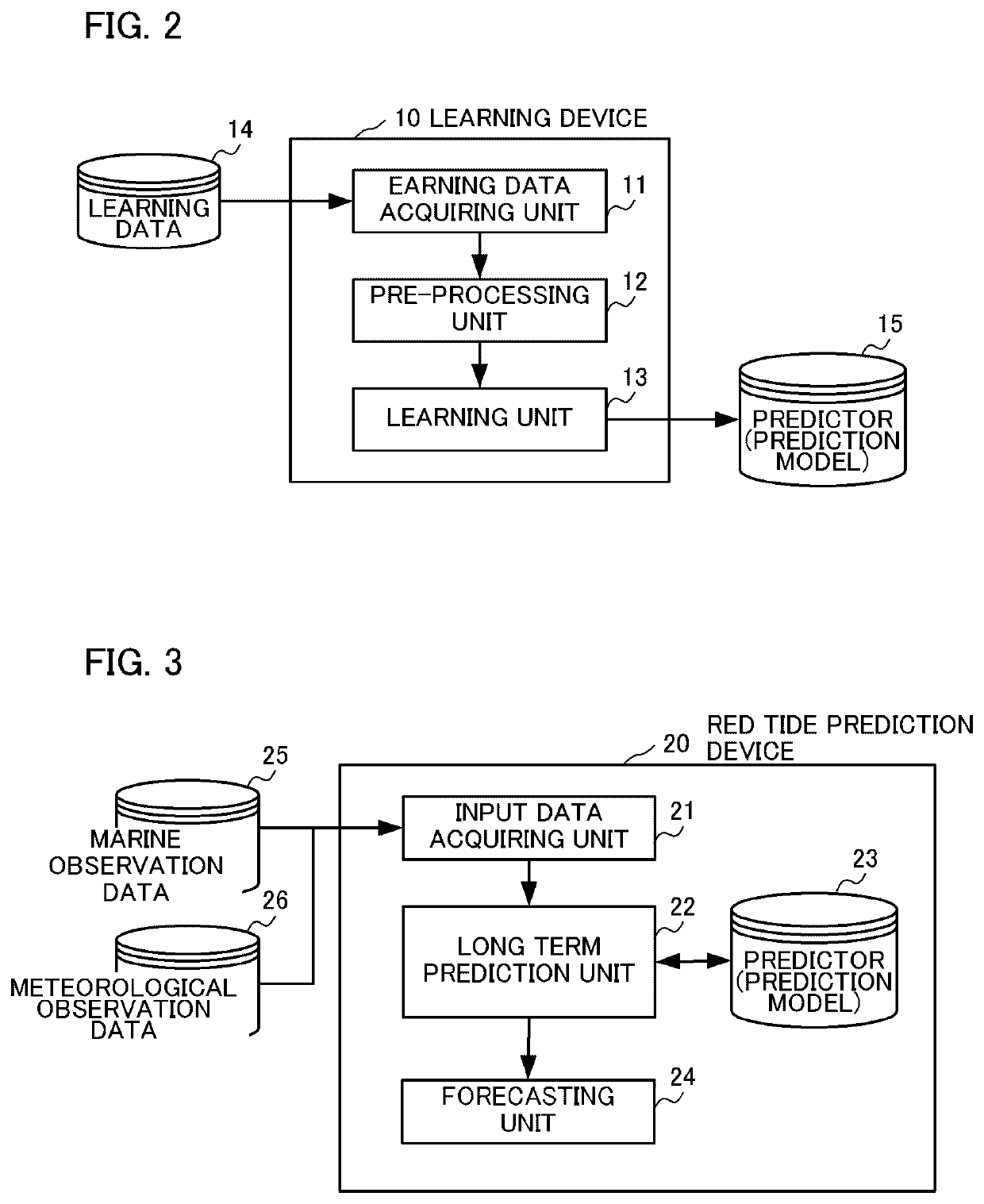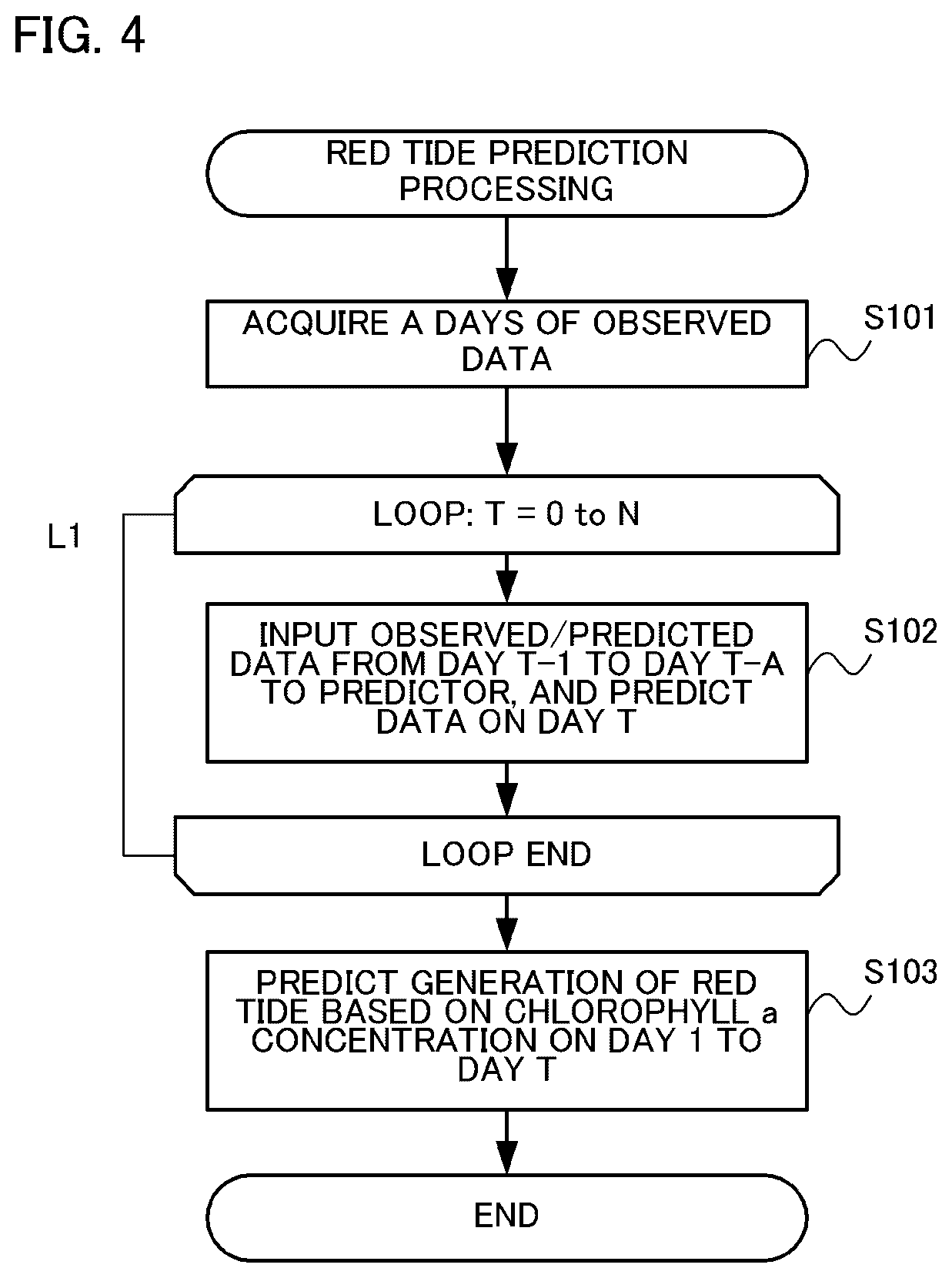Device, method and program for environmental factor estimation, learned model and recording medium
a technology of environmental factors and learning models, applied in the field of environmental factor prediction, can solve the problems of insufficient prediction accuracy, unclear, insufficient prediction accuracy, etc., and achieve the effect of high accuracy
- Summary
- Abstract
- Description
- Claims
- Application Information
AI Technical Summary
Benefits of technology
Problems solved by technology
Method used
Image
Examples
embodiment 1
[0040]Embodiments of the present invention will be described with reference to the drawings, but the present invention is not limited to the embodiments. Composing elements of each embodiment which will be described herein below may be combined when necessary. In the following embodiments, sea water data is handled as target data to predict the generation of red tide. In the case of predicting the generation of blue tide as well, sea water data is handled as target data. And in the case of predicting the generation of water bloom, fresh water data is handled as target data.
[0041]As a species that generates red tide, plankton, belonging to diatoms, Raphidophytes, Gonyaulaxes, Cryptomonads, ciliates, and the like, are known. All of these plankton contain chlorophyll-a and chlorophyll-c. In the present embodiment, concentration of chlorophyll-a and / or chlorophyll-c, among chlorophylls, is selected as an explanatory variable, whereby the start or end of red tide is forecasted.
[0042]The ...
example 2
ANALYSIS EXAMPLE 2
[0089]Next, using the same method as Analysis Example 1, learning and prediction were performed without using the wind velocity data. The data used for the analysis is essentially the same as the Analysis Example 1 described above, but a number of explanatory variables is 44 items, since 8 items related to the wind velocity were removed from the above mentioned 52 items.
[0090]FIG. 9A is a graph when 7 years of observed data was used as the learning data, just like the Analysis Example 1, and the last 1 year of data was used as the test data. The prediction result by the predictor which was learned using a GRU algorithm is superimposed on the observed data in FIG. 9A. The prediction error is 18.11 μg / L, which means that sufficient accuracy was acquired even if the prediction accuracy was lower than Analysis Example 1.
[0091]FIG. 9B indicates the result of recursively inputting the predicted values into the created prediction model for one day later, and performed lon...
example 3
ANALYSIS EXAMPLE 3
[0092]In the method described in the Analysis Example 1, sampling data of sea water was also added to perform the learning and prediction. Here, for the sampling data, 7 items including Karenia brevis were used as the microorganism data included in the water sample, 214 items including amino acids and saccharides were used as the organic substrate data, and 20 items including nitrogen, phosphorus and silicon were used as the inorganic substance data. Out of the 52 items of the marine data and meterological data, 33 items were used, since 19 items of daily total values were not used.
[0093]In Analysis Example 3, 3 years of data acquired at Kawasaki Artificial Island were used for learning. For many missing values included in each data, interpolation was performed based on a k-nearest neighbor algorithm (KNN). FIG. 10A to FIG. 10C indicate examples of the observed data and interpolated data of Gonyaulax (marine microorganism), glycine (organic substance) and silicon (...
PUM
 Login to View More
Login to View More Abstract
Description
Claims
Application Information
 Login to View More
Login to View More - R&D
- Intellectual Property
- Life Sciences
- Materials
- Tech Scout
- Unparalleled Data Quality
- Higher Quality Content
- 60% Fewer Hallucinations
Browse by: Latest US Patents, China's latest patents, Technical Efficacy Thesaurus, Application Domain, Technology Topic, Popular Technical Reports.
© 2025 PatSnap. All rights reserved.Legal|Privacy policy|Modern Slavery Act Transparency Statement|Sitemap|About US| Contact US: help@patsnap.com



